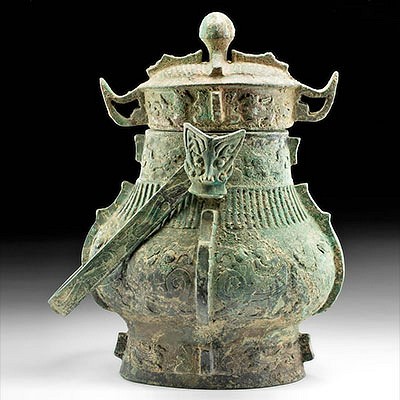Achaemenid Bronze Hinges with Lions - Rare!
Lot 40b
About Seller
Artemis Gallery
686 S Taylor Ave, Ste 106
Louisville, CO 80027
United States
Selling antiquities, ancient and ethnographic art online since 1993, Artemis Gallery specializes in Classical Antiquities (Egyptian, Greek, Roman, Near Eastern), Asian, Pre-Columbian, African / Tribal / Oceanographic art. Our extensive inventory includes pottery, stone, metal, wood, glass and textil...Read more
Estimate:
$2,400 - $3,600
Absentee vs Live bid
Two ways to bid:
- Leave a max absentee bid and the platform will bid on your behalf up to your maximum bid during the live auction.
- Bid live during the auction and your bids will be submitted real-time to the auctioneer.
Bid Increments
| Price | Bid Increment |
|---|---|
| $0 | $25 |
| $300 | $50 |
| $1,000 | $100 |
| $2,000 | $250 |
| $5,000 | $500 |
| $10,000 | $1,000 |
| $20,000 | $2,500 |
| $50,000 | $5,000 |
| $100,000 | $10,000 |
| $200,000 | $20,000 |
About Auction
By Artemis Gallery
Jul 1, 2020
Set Reminder
2020-07-01 10:00:00
2020-07-01 10:00:00
America/New_York
Bidsquare
Bidsquare : Ancient | Near-Eastern | Asian Art
https://www.bidsquare.com/auctions/artemis-gallery/ancient-near-eastern-asian-art-5276
Ancient art from Egypt, Greece, Italy and the Near East, as well as Asian, Fossils, Pre-Columbian, Native American, African / Tribal / Oceanic, Spanish Colonial, Russian Icons, Fine art, much more! Artemis Gallery info@artemisgallery.com
Ancient art from Egypt, Greece, Italy and the Near East, as well as Asian, Fossils, Pre-Columbian, Native American, African / Tribal / Oceanic, Spanish Colonial, Russian Icons, Fine art, much more! Artemis Gallery info@artemisgallery.com
- Lot Description
Ancient Near East, Achaemenid Empire, ca. 500 to 330 BCE. Truly exceptional and rare, a handsome pair of leaded bronze hinges, each bearing cast via the lost wax (cire perdue) process, and comprised of a cylindrical form adorned by two lion heads, one at each end, and a pointed arrowhead extension. The wild feline faces are replete with details: heavy lidded almond-shaped eyes, aquiline noses, laid back ears, and striated manes. Lions were symbols of Achaemenid royalty, as evidenced by the enormous bronze lion-weight and the lion frieze in enameled brick found in the palace at Persepolis. Size: 7" W x 5.125" H (17.8 cm x 13 cm); 8.375" H (21.3 cm) on included custom stand.
According to Elspeth R. M Dusinberre, "Lions or parts of lions were an important element in Achaemenid Persian iconography of architectural and royal furniture support (addorsed capitals, platforms supporting the kin on royal tomb facades, feet and legs of thrones and footstools, etc.) In addition to the relief sculptures of Persepolis and Naqush-I Rustam, the free-standing bronze support from the Treasury of Persepolis in the form of three walking lions is well known. . . . Lions had a long history in Persia as well as Lydia: their connections to kinship and to Kybele, to apotropaic forces and to connotations of power, make it small wonder they should have such preponderance in the sculpture of Achaemenid-period Sardis." ("Aspects of Empire in Achaemenid Sardis" Cambridge University Press, 2003, p. 103)
Provenance: private East Coast, USA collection, collected prior to 2008
All items legal to buy/sell under U.S. Statute covering cultural patrimony Code 2600, CHAPTER 14, and are guaranteed to be as described or your money back.
A Certificate of Authenticity will accompany all winning bids.
We ship worldwide and handle all shipping in-house for your convenience.
#137066Old iron pins lodged in a few of the drilled openings. Encrustation on concave versos. Lion heads present wonderful details and overall forms are very strong. Both present a gorgeous green patina that has developed over the ages.Condition
- Shipping Info
-
All shipping is handled in-house for your convenience. Your invoice from Artemis Gallery will include shipping calculation instructions. If in doubt, please inquire BEFORE bidding for estimated shipping costs for individual items.
-
- Buyer's Premium



 EUR
EUR CAD
CAD AUD
AUD GBP
GBP MXN
MXN HKD
HKD CNY
CNY MYR
MYR SEK
SEK SGD
SGD CHF
CHF THB
THB















